Have you ever heard of or seen blue tea, perhaps on TikTok? If you haven’t, then you’re in for a treat— blue matcha is a one-of-a-kind, vibrantly-colored tea that comes with some pretty great health benefits.
Last week I shared one of my favorite coffee alternatives, a chocolate blue matcha latte, so this week I'd like to cover— what is blue matcha?
The base ingredient, butterfly pea flower, has been used for reducing stress and anxiety since ancient times. Ayurvedic medicine has actually used butterfly pea flower powder for millennia to help restore cognitive health, relieve anxiety, resist oxidative stress, and illuminate your skin.
This pleasant beverage has been gaining ground among tea enthusiasts for its subtle, light flavor. It’s generally considered much gentler and milder than green matcha. Smooth, velvety, delicious, and caffeine-free, blue matcha can also be used as a natural food colorant in cooking and baking.

Jump To
What is Blue Matcha? (Butterfly Pea Flower)
Let's begin by defining what green matcha is. Although most people associate matcha with pure green tea powder, it’s slowly become a catch-all term for any ground tea.
However originally, matcha is a Japanese word that can be broken up into “ma” which means rubbed or ground and “cha” which means tea. So despite the common green tea association, the literal translation of matcha is “ground tea.”
Blue matcha, which is also known as butterfly pea flower powder, comes from the Clitoria ternatea, an edible flowering plant in the Fabaceae plant species. The species’ name is thought to be derived from Ternate, a city in the Indonesian archipelago where Linnaeus' specimens were discovered.
Butterfly pea powder is cultivated and its flowers are ground into a fine blue powder. Not to be mistaken as merely a blue-tinted green matcha tea, blue matcha tea is a tisane made from a decoction or infusion of the blue pea plant's leaves. This herbal tea is completely caffeine-free.
Its roots can be traced back to tropical equatorial Asia, particularly South and Southeast Asia. The flower was widely distributed throughout the centuries, and has even naturalized in many countries around the world including Australia, Jamaica, the Bahamas, Cuba, Africa, Asia, and parts of the U.S. (like Hawai’i).
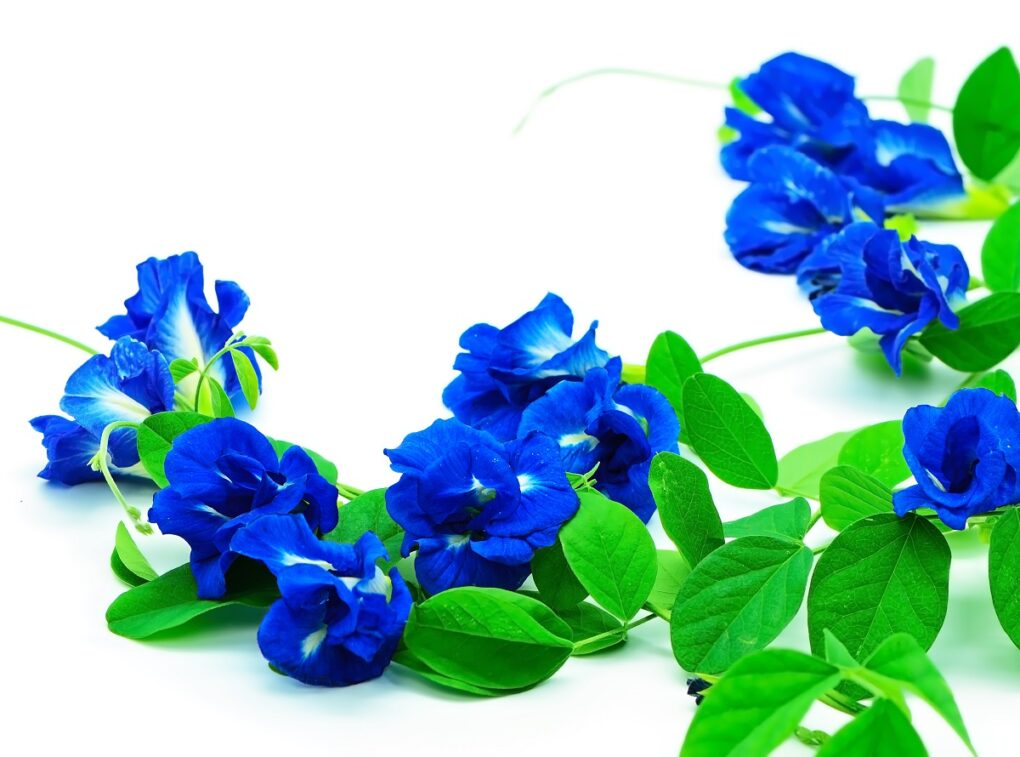
Also known as Asian pigeonwings, bluebell vine, blue pea, butterfly pea, blue ternate, cordofan pea, or Darwin pea, blue matcha is actually revered as a holy flower in India and is used in daily puja rituals. Additionally the pea flower has been used to dye natural fibers in traditional Asian societies.
The blue color of the plant comes from antioxidant anthocyanins, which are widely used as a natural source of food coloring in Southeast Asia to color glutinous rice and desserts.
The petals have been used as a food coloring agent in Thai, Malay, Nyonya, and Peranakan cuisines, because it doesn’t change the flavor of any dish or drink. In Malaysia and Singapore, it is used in Malay dishes such as nasi kerabu, the Eurasian kuih putugal, and pulut tai tai.
Butterfly pea flower, extract, or powder is traditionally shredded into fine ribbons and added to rice salad, as well as used to color traditional snacks such as steamed chaw muang dumplings and pale purple khanom chan cakes.
These blue flowers are used in the Philippines to make bikong asul and a color-changing gin (also found in Australia). When mixed with acidic or carbonated mixers, the blue-tinged gin turns pink!
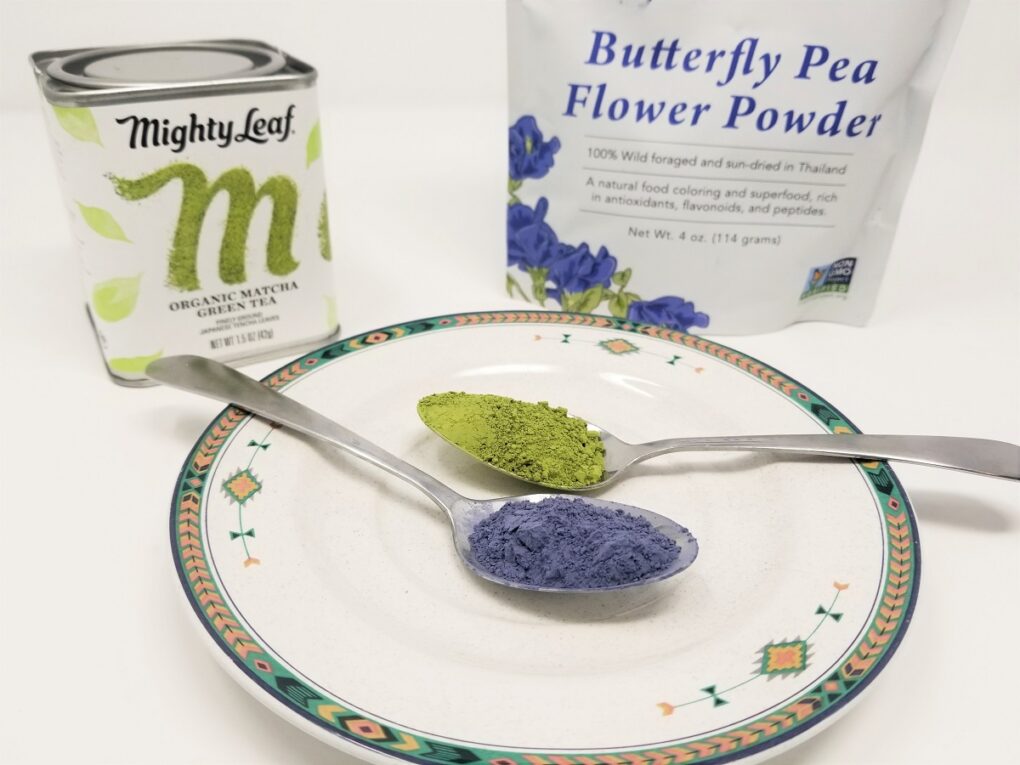
Blue Matcha vs. Green Matcha
Though blue and green matcha teas have many similarities, they also have some key differences. Perhaps the most striking difference is that the various types of matcha are derived from two distinct plants.
Blue Matcha is made from blue butterfly pea flowers, Clitoria ternatea, while green matcha is derived from the Japanese green tea plant Camellia sinensis.
Green matcha is made from the plant's leaves, while blue matcha is made from the plant's flowers. Green matcha's origins can be traced all the way back to the Tang Dynasty in China; it's a powder made from specially grown and processed green tea leaves.
Matcha was introduced to Japan by a Buddhist monk who planted it on temple grounds in Kyoto during the Song dynasty. The plants thrived in the shade, enhancing the health benefits and altering the flavor of green matcha.
It’s traditionally consumed in East Asia, but has grown in popularity throughout the world, particularly in the United States. Aside from the different plant types, the two ground teas differ in taste and color, as well as providing entirely different health benefits.
Blue matcha's mild flavor makes it more appealing to drink than green matcha, whose deep earthiness can be an acquired taste. As a tea, it has a mild woody, soft floral, earthy taste.
Its light flavor is easy to like, whereas green tea can taste differently depending on the grade or type. Ceremonial green tea has a complex flavor profile that includes mellow vegetal grassy notes, natural sweet nuttiness, a hint of bitterness, and a pleasantly savory finish.
Culinary matcha has a bold, naturally sweet, vegetal grassy flavor with a smooth and creamy finish. Blue matcha does not contain as many antioxidants as its popular green counterpart, whose antioxidants are said to help prevent aging and fight cancer.
Blue matcha, on the other hand, has a different nutritional profile.
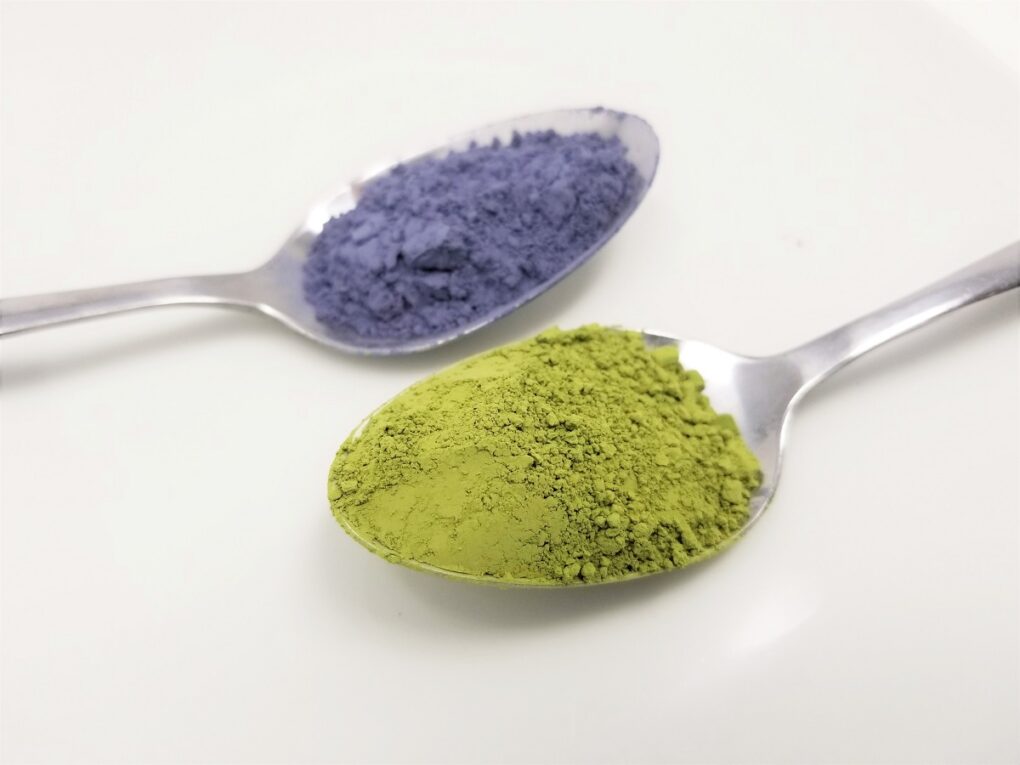
Blue Matcha Benefits
While green matcha is a popular coffee alternative for its many health and wellness benefits, it isn’t the only option available. Blue matcha tea, a type of herbal tea that doesn’t come with any caffeine, is also an excellent choice.
It produces a beautiful and brilliant blue color and can be used in a wide variety of blue dessert recipes.
Although it lacks the verified and quantifiable health and wellness benefits of green matcha, there are numerous reasons to switch to this coffee alternative. Blue matcha has numerous health benefits and is caffeine-free.
One of the primary advantages of drinking blue tea or butterfly pea tea is its high antioxidant content. Butterfly pea's deep indigo flowers are high in vitamins and minerals, as well as flavonoids and peptides, which are actually the element which gives it its color.
Flavonoids, which are found in almost all fruits and vegetables, are powerful antioxidants. They help to combat free radicals, which are the primary cause of premature aging of the body.
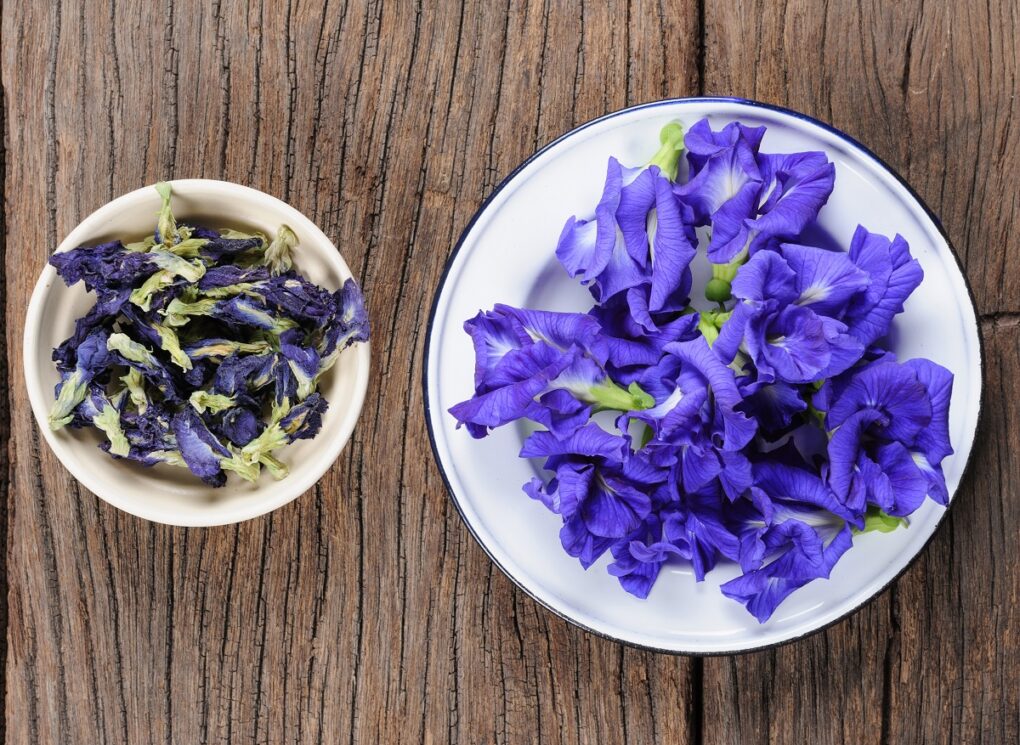
It has shown considerable promise in alleviating cardiovascular illness in animal studies. It has antimicrobial, anti-inflammatory, immune-boosting, and anti-diabetic properties that aid in the prevention of various illnesses including fever, inflammation, pain, diabetes, and the regulation of blood sugar levels.
Here are some of the benefits of blue matcha:
- Enjoy it regularly to make your hair and nails are grow stronger and longer
- Can help you lose weight and aid in detoxification by cleansing the liver, kidneys, intestines, and stomach
- It also aids in the improvement of brain function and memory
- It’s an excellent choice for those who suffer from joint stiffness or stress from sitting in the same office chair all day
- Because it targets the nervous system and reduces feelings of anxiety
- Drink blue pea tea to help you manage the effects of stress
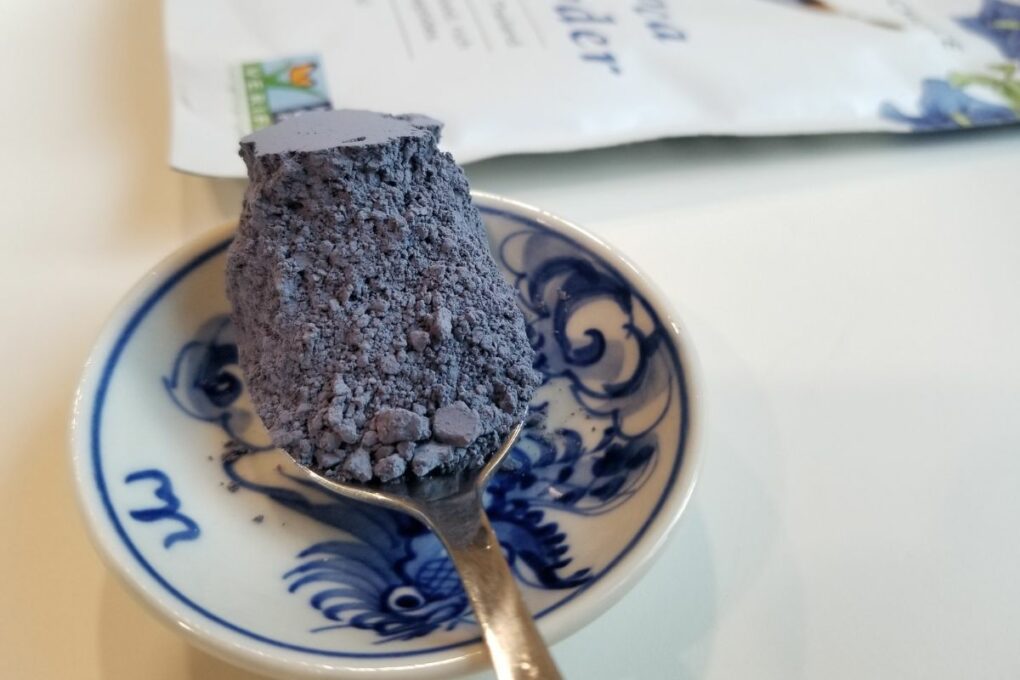
Blue Matcha Recipes
This green matcha substitute can be consumed as a simple tea with water. Simply whisk some of the powder into water for a hot or cold beverage, or with milk for an extra creamy latte.
Blue matcha has a versatile flavor that can be used in a variety of recipes. It goes well with dairy and cream ingredients, so try it in your morning latte or as part of a coconut milk-based drink with agar, nata de coco, or boba.
It adds a beautiful blue, purple color to recipes in addition to all of its incredible health benefits. Get creative with blue matcha and blend it into smoothies or prepare a simple and refreshing tea by steeping blue matcha flowers for a natural & vibrant blue tinge.
This blue matcha latte recipe is both beautiful and easy to make. Enjoy the nutritious, mild-tasting, and absolutely caffeine free beverage at any time of the day.
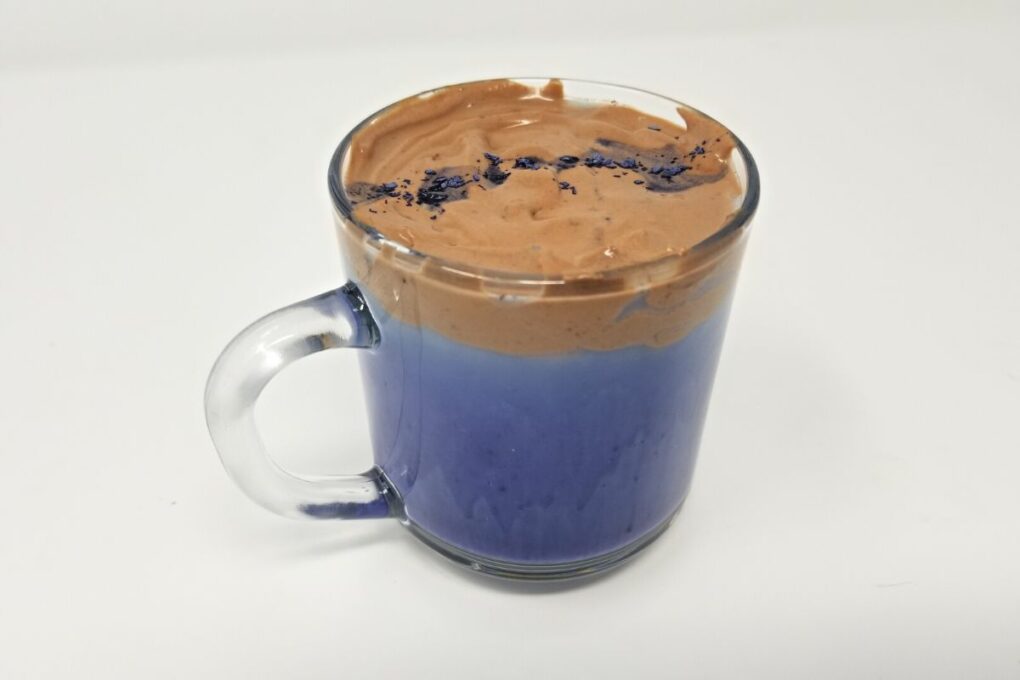
Ever had nutritious and beautiful blue rice? Try this unique way of serving a simple rice dish by cooking your rice with blue pea flowers.
Need a nice blue-tinged sweet confection for your next soiree? Take a look at this beautiful blue chocolate cavity cake using blue matcha powder and a blue pea garnish.
You can also use blue matcha as an ingredient in cocktails or use blue matcha powder to add a beautiful hue to your cakes and cookies. There are many blue matcha recipes out there for you to begin enjoying this delightful flower and reaping its healthful benefits.
Following green matcha’s pure growing, harvesting, and refining methods, there are a handful of blue matcha powder manufacturers out there. Higher-quality products have a slightly creamier texture than other powders, though my favorite is from Ancient Choice.
For other brands of high-quality culinary blue matcha powder, check out Orgnisulmte or Wixar Naturals.













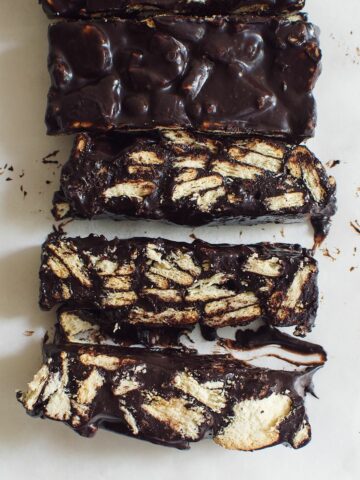



Comments
No Comments